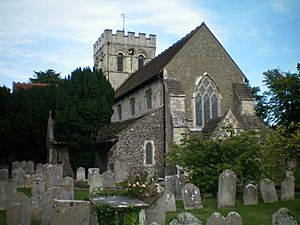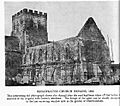St Mary's Church, Broadwater facts for kids
St. Mary's Church, Broadwater is a special church in West Sussex, England. It's part of the Church of England and serves the local community of Broadwater, West Sussex. The church is named after St. Mary and is one of several churches in the area that work together. It's a place where people gather for worship and community events.
Contents
A Look Back: The Church's History
Early Beginnings: Saxon and Norman Times
The church building stands on a very old site where a Saxon church once stood. We know this because the Domesday Book from 1086 mentions a church in "Bradewatre." You can even see a Saxon doorway on the south side of the chancel (the area around the altar) that was found during repairs in 1936. Other old Saxon stone pieces are hidden inside the walls of the church tower.
The church you see today was first built in the Norman style around the mid-1100s. It was made using Caen stone (a type of limestone) and flints. The first church was smaller, with a tower, a short nave (the main part where people sit), and a chancel.
Growing Bigger: Medieval Changes
In the 1200s, the church became much larger. The chancel was made longer, and the nave was both lengthened and widened. At the same time, north and south transepts (parts of the church that stick out like arms, making a cross shape) were added. These helped make the tower stronger.
Three small chapels, called chantry chapels, were also built off the north transept. These were removed in 1826, but you can still see where they used to be from outside. The church tower was also made taller, reaching 60 feet high, to hold bells.
One of the most interesting parts of the church is the large arch at the west end of the tower. In the 1200s, the tower started to sink a little on one side. To fix this, the arch was rebuilt in a Gothic style using the original Norman stones. When you look at it from the nave, you can see both the Gothic and Norman styles mixed together, which is quite unique!
Later Updates: 15th to 19th Centuries
The church had more changes in the 1400s. The main entrance, the north door into the nave, was updated, and a porch was added. Windows and pillars inside the nave were also changed. A low screen was put in front of the chancel. In 1599, Queen Elizabeth I ordered the removal of the altar slabs. You can still see parts of an old medieval altar made of Sussex Marble near the screen.
In 1819, a west door was added, and a gallery (a raised seating area) was built at the west end. In 1826, the short wooden spire on the tower was taken down. The three chapels were removed, and the north transept was even used as a school for a while! Box pews (like individual boxes for families) were put in the nave, and more galleries were built.
The tower was given a new look in 1830 with battlements (like the top of a castle wall) and a small turret.
Major Renovations: Victorian Era and Beyond
From 1852 to 1855, the tower was made even stronger. The chancel walls were straightened, the roof was replaced, and the floor was raised and tiled. Most of the old windows were replaced, except for one from the 1400s. The churchyard was closed for new burials after this time. A kind lady named Ann Thwaytes helped pay for some of these repairs.
The church was closed for two years between 1864 and 1866 while the nave roof was replaced. All the galleries were removed, and the box pews were replaced with the pews you see today. Central heating was also installed! A new stone pulpit (where the preacher stands) was added, designed by Charles Hide.
In 1887, the west end of the church was rebuilt. In 1901, a local newspaper article started a rumor about a secret tunnel from the church, but there's no proof of it! A clock was placed in the tower in 1903 to celebrate Reverend E. K. Elliot's 50 years as rector.
In 1938, the church's six old bells from 1712 were melted down and recast, and two new bells were added. In 1953, a beautiful stained glass window was put in the south wall of the chancel, showing John Wycliffe and a group of preachers.
More recent changes include a wooden platform under the west arch in 1986 and renewed tower battlements in 1989. From 2001 to 2009, the church had a big "reordering" project. This included new lighting and heating, an improved toilet and kitchen, and a new room upstairs in the north transept. All the pews were removed from the nave, and a new limestone tile floor with underfloor heating was installed.
In 2018, another church group, the Hosanna congregation, joined St. Mary's. From 2020 to 2021, more changes were made, including converting the kitchen into a toilet, making a larger kitchen, and adding an extension for a bigger creche (a place for young children).
Important Monuments and Memorials
Honoring Important People
St. Mary's Church has several interesting monuments that remember important people from its past.
One of the most famous is the monument to Thomas West, 8th Baron De La Warr, found on the north wall of the chancel. He was buried in the church in 1524, and his tomb was discovered under the nave floor in 2009. His son, also named Thomas, who died in 1554, has a stone monument made of Caen stone at the east side of the south transept. His third wife, Eleanor Copley, is buried with him.
There is also a special brass memorial for John Mapulton, who was the church's rector from 1424 to 1431. He was an important clerk for the Court of Chancery and worked for Queen Joanna, the wife of King Henry IV.
Old Brasses and Brave Fishermen
Two very old and well-preserved brass memorials were found under old pews in 1826. They were first placed in the center aisle of the nave and then moved in 2007 to stand upright in the north transept. The main brass cross remembers Reverend Richard Tooner, who passed away in 1445. Below it is a memorial to John Corby, who was rector from 1393 to 1415.
The church also has a brass memorial dedicated to 11 brave fishermen. They died in 1850 while trying to rescue the crew of a ship called the Lalla Rookh, which was caught in a storm off Worthing.
The famous surgeon John White is buried in the churchyard.
Other Burials
- Reginald West, 6th Baron De La Warr
- Thomas West, 9th Baron De La Warr
- Sir George West (died 1538)
Rectors of St. Mary's
The rector is the main priest in charge of the church. Here are some of the rectors who have served St. Mary's Church over many centuries:
- Gaz Daly (2016–Present)
- Peter Irwin-Clark (2008–2015)
- John Berry (1998–2007)
- Peter Dominy (1984–1997)
- William Filby (1979–1983)
- Peter Marrow (1953–1978)
- Basil Mowll (1927–1952)
- Edward J Elliott (1906–1926)
- Edward K Elliott (1853–1905)
- Peter Wood (1797–18xx)
- Richard Russell (17xx)
- Richard Basset (1762–17xx)
- Samuel Terrick (1745–1761)
- Jeremiah Dodson (1714–1744)
- William Wade (1670–16xx)
- John Wood (1663–1669)
- Thomas Porter (1661–1662)
- Dr Edward Burton (1646–1660)
- Dr Granado Chester (1624–1645)
- Richard Holden (15xx–15xx)
- Francis Heydon (1575–15xx)
- James Wynnybank (1559–1574)
- R Cromar (15xx–1558)
- Reginald Harrison (1541–15xx)
- Reginald Sandys (1535–1540)
- John Lewknore (1521–1534)
- Jardin Kybow (1481–14xx)
- John Lamporte (1478–1480)
- Patrick Grebe (1457–1477)
- William Treverdon (1445–1456)
- Richard Tooner (1432–1444)
- John Mapulton (1424–1431)
- Thomas Lynche (1416–1423)
- John de Corby (1393–140x)
- Reginald de Newton (1373–1392)
- Walter Gest (1349–1372)
- Peter de Conshill (1322–1348)
- John de Chyshelle (also known as John Chishull) (1259–12xx)
- William (1248–1258)
- William (1190–1xxx)
A notable curate (another type of priest) of the church was George Baillie Duncan in the 1930s.
Images for kids



